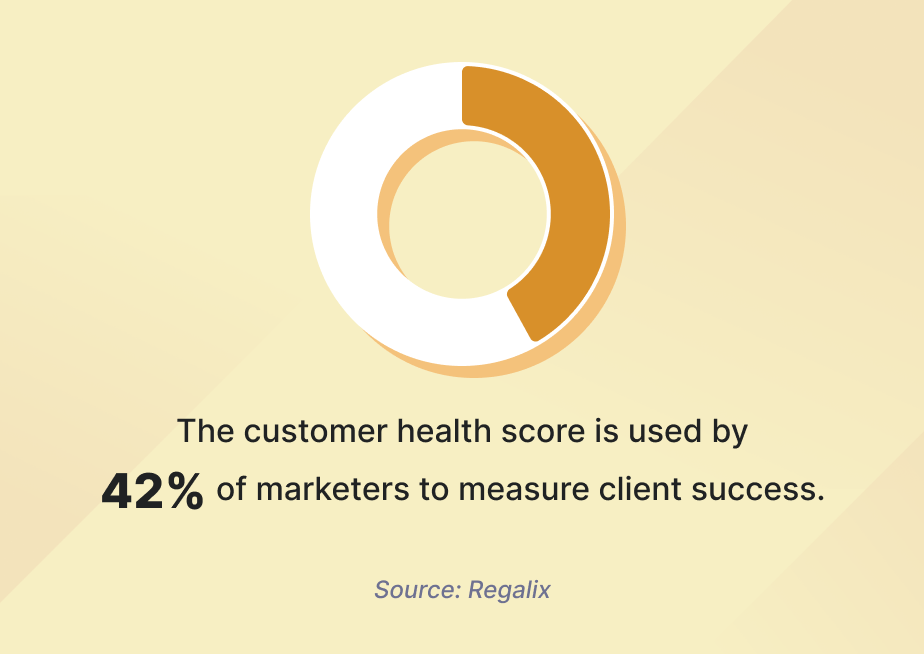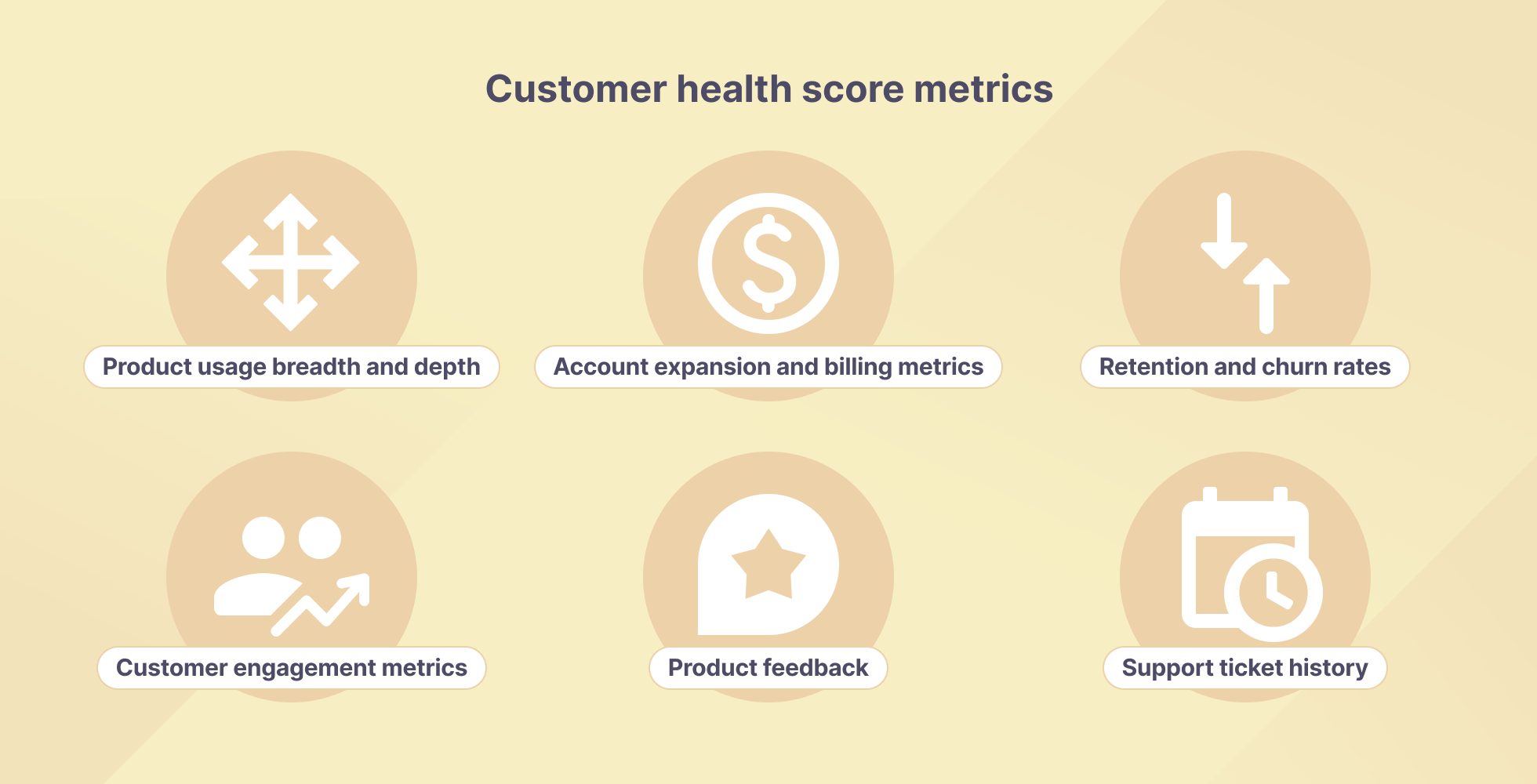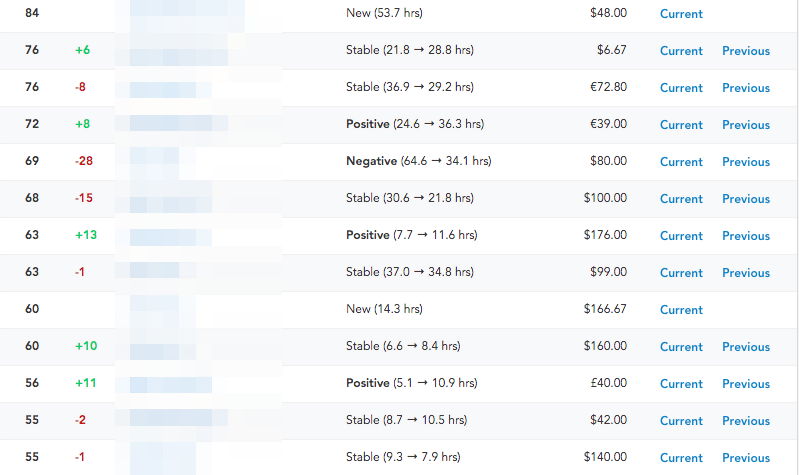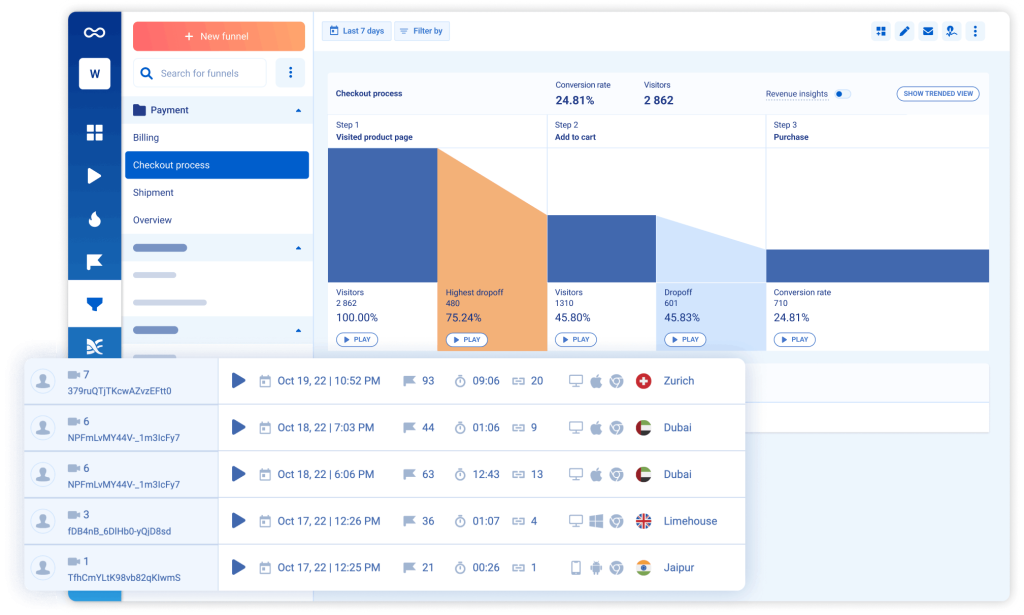
Customer health scores are metrics that reduce customer churn and ensure sustained business growth. They can help prevent pitfalls related to poor service or fragile customer bonds.
Rather than always playing catch-up, businesses can use customer health scores to understand and manage expectations and sentiments proactively.
Statistics show that these metrics are used by 42% of marketers globally. So, to help you maximize the benefits of these indicators, we’ll dive deep into the meaning, importance, and metrics of customer health scores. You’ll also learn how to calculate and improve them from this article.

What is the customer health score?
The customer health score is a critical metric that gauges customer satisfaction and engagement with a company. It reflects the likelihood of a client staying with the brand.
The customer health score is calculated based on various factors like product usage, customer feedback, and interaction frequency. Companies identify criteria to assign points based on customer behaviors or actions.
The higher the score, the “healthier” the customers are. “Healthy” customers are satisfied and engaged, making regular purchases and bringing in new clients. “Unhealthy” customers are getting increasingly disconnected and are likely to leave the brand. This negative trend may be due to the failure of the company to meet their evolving needs.
The importance of the customer health score
The significance of the customer health score goes beyond merely providing numerical values. It’s a visionary tool that enables brands to navigate customer pain points and nurture lasting relations. Here are the primary benefits of knowing your customers’ health score:
- Revealing success and failure trends: Customer health scores can indicate what’s working and what’s not, facilitating better decision-making and strategy formulation.
- Spotting brand champions: You can recognize the most loyal supporters of your brand so you can take steps toward turning them into brand advocates.
- Mitigating customer churn: By identifying potential churn risks early, you can address the problem proactively and retain valuable customers.
- Data-driven improvements: The insights are instrumental for making informed enhancements in product or service offerings.
- Unlocking upsell and cross-sell prospects: Identifying satisfied customers opens doors for upselling or cross-selling opportunities.
- Enhanced customer engagement: Monitoring health scores provides a deeper understanding of customer engagement levels.
- Strategic resource allocation: The data gathered enables you to channel focus and resources toward optimizing overall efficiency.
Customer health score metrics
The customer health score is a dynamic metric. It embraces multiple aspects of customers’ experiences with your business. Here are some important metrics to track before starting to calculate your customer health score:

Product usage breadth and depth
Product/service usage sheds light on the user interaction with your product. This way, it provides a glimpse into varying degrees of adoption. It’s a quantitative indicator tracking:
- Login history
- Time in app
- Engagement with new or sticky product features
- Consumption of purchased licenses
- Utilization of online resources and training
This metric allows you to gauge the extent to which users are taking benefit from your product. You can also comprehend the spectrum of adoption rates and levels.
Here are the aspects of evaluating product/service usage.
- The breadth of product/service usage: Takes into account the average duration a user engages with your product/service or a specific feature.
- The depth of usage: Evaluates the variety of features or services utilized, which may indicate a deeper engagement or satisfaction.
- Overall product/service usage: Measures the extent of product/service utilization by customers, indicating their reliance and satisfaction.
Account expansion and billing metrics
- Account growth monitors the expansion within customer accounts. It reflects on the growing value they find in your services.
- Tracking upsells indicates the willingness of customers to invest more in your products or services.
Retention and churn rates
- The number of renewals directly indicates customer satisfaction and is a testament to the perceived value.
- The churn rate illustrates the retention capability of a company by showing the ratio of customers lost to those retained.
💰 All companies should analyze churn, as it directly impacts profitability and is an indicator of potential financial gains through customer retention strategies.
Customer engagement metrics
Engagement is tracked through three individual metrics, clearly indicative of customer health.
- Customer satisfaction (CSAT): CSAT measures satisfaction per interaction or overall, utilizing a 5-point response scale. It’s evaluated by averaging scores or tallying satisfied responses.
- Net promoter score (NPS): Unlike CSAT, NPS assesses satisfaction by querying the likelihood of product recommendations to others. It segments responses into detractors (1-6), passives (7-8), and promoters (9-10). The NPS is the promoters’ and detractors’ percentage difference.
- Customer lifetime value (CLV): CLV extends beyond single transaction values to ascertain overall engagement worth. It’s fundamental for optimizing resource allocation, understanding customer loyalty, and improving retention.
Product feedback
This metric shows customers’ perceptions of your product. It offers important insights by tracking quantitative factors like the frequency of bug reporting and product requests. Keeping track of these aspects helps identify potential areas of improvement.
Support ticket history
High demand for support might indicate underlying issues with your product or service. Tracking customer support tickets encapsulates the interaction history between a company and its customers. This entails recording essential details like the nature of issues raised.
Support ticket history is a quantitative metric involving:
- SLA fulfillment
- Support ticket volume
- Response time
- Resolution time
- Severity of cases
- First contact resolution (FCR) rate
📈 Analyzing these metrics can uncover recurring issues, offering a roadmap for product/service improvements. It also can provide indispensable information for your product-led growth strategy.
How to calculate the customer health score
Understanding and calculating the customer health score can help anticipate customer behaviors. A well-structured approach involves the following steps.
1. Outline a customer health framework for your business
The concept of customer health is different for different businesses. The customer health score evaluation starts with pinpointing a healthy customer’s attributes in your specific scenario. This may entail the time users interact with your product or the range of features they use regularly.
2. Apply customer data segmentation
The accuracy of the customer health score is improved when applied to the relevant customer segments. Segmentation is usually based on several criteria:
- Demographic and occupational characteristics
- Market and sample size
- Channels used
- Business verticals
3. Identify the relevant customer behaviors
Analyze the full range of possible actions customers can take, such as:
- Logging in and out
- Product engagement duration
- Support ticket generation
- Brand interactions on social media and other communication channels
- Responses to in-app surveys
- Feature utilization and engagement
- Account upgrades
- Purchasing additional products
Then, single out the behaviors that significantly impact the customer health score. Ensure you include both positive and negative actions. The positive ones will add points to the health score. On the other hand, negative actions will deduct points.
4. Allocate impact scores to actions
Note that customer behaviors don’t influence the health score equally. Once you’ve identified the impactful customer actions, you have to assign a weighted score to each identified action. This process is based on its relevance to customer satisfaction.
Actions central to your service should carry higher scores. For instance, a critical positive action in a digital tutoring platform could be booking a tutor, thus assigning the highest score (e.g., 20). A less important action, such as visiting your site, will carry fewer points (say 3).
Conversely, account deactivation, negative feedback on sessions, or rescheduling might signify dissatisfaction, bringing different numbers of points (let’s 20, 8, and 3, respectively). They will be subtracted when calculating the total customer health score.
5. Calculate the total customer health score
Utilizing the assigned impact scores, tally the total action value for each customer. The formula is straightforward:
CHS = (Sum of positive action values) – (Sum of negative action values)
The sum of all positive values is the sum of the products of the scores of all positive actions and the respective times they occurred. The sum of negative values is calculated similarly.
Let’s break it down with our illustrative scenario above. It involves two positive and two negative actions. The formula takes this form:
(Positive action 1 count × Positive action 1 score) + (Positive action 2 count × Positive action 2 score) − (Negative action 1 count × Negative action 1 score) − (Negative action 2 count × Negative action 2 score)
We’ll use score 20 for positive action 1 and score 3 for positive action 2. As for negative actions, the scores for negative action 1 is 8, while for negative action 2 is 3.
In our case, the positive actions 1 and 2 occurred once and seven times, respectively. The negative actions occurred once each. The formula simplifies as follows:
Positive actions (1×20 + 7×3) − Negative actions (1×8 + 1×3)
Thereby:
CHS = 41 − 11 = 30.
Here, the customer health score is 30.
6. Establish your customer health scale
Create a scale to categorize customers based on their scores, such as:
- At risk in case of a negative customer health score (below 0)
- Needs attention in case of a customer health score between 0 and 35
- Satisfactory with a customer health score between 36 and 70
- Healthy in case of a customer health score between 71 and 100
- Thriving with a customer health score of over 100
Note that these numbers are only exemplary. The maximum score depends on the formula used. So, you’ll need to determine your scale in line with your specific scenario.
Also, this is just one of the possible scales you can employ. We’ll come back to this point in a while.
7. Automate data collection and continuously improve
Automate the process using tools to facilitate collecting the necessary data, such as voice of the customer surveys. Continuously refine the metrics, weights, and action plans based on outcomes and feedback.
8. Define action plans for each health category
Formulate tailored strategies for different health categories. For instance, plan retention initiatives for “At risk” customers while exploring upsell possibilities with “Thriving” customers.
Adhering to this structured approach ensures a well-rounded calculation of customer health scores. Clear visualization of the figures obtained will further increase the usefulness of the findings. This brings us to the next point.
Customer health score examples
Understanding customer health is instrumental in nurturing relationships and ensuring sustained business growth. Scoring methodologies vary, employing numerical points, letter grades, or color-coding systems.
Here, we discuss the various approaches to translating customer health scores into meaningful, clearly visualized insights. Each of the following examples offers a unique lens through which to view and interpret data.
Make your choice based on the nature of your business and customer interactions.
Alphabetical scale
This visual cue is easy for teams to interpret, offering an immediate insight into customer health status.
Following a grading system like in schools, scores 90 and above receive an A, 80 to 89 receive a B, 70 to 79 a C, 60 to 69 a D, and below 60 an F.

This grading system facilitates easy communication and understanding of customer health within teams. Utilize our fully customizable template to sort your customers’s health alphabetically.
Color-based scale
Analogous to traffic light colors, categorize customer health into green (good), yellow (caution), and red (poor).
Suppose a range of scores from 0 to 100, scores 75 and above are categorized as Green, scores 50 to 74 as Yellow, and scores below 50 as Red.

This visual cue is easy for teams to interpret, offering an immediate insight into customer health status. Our template allows you to check which customers require your immediate attention.
Percentage scale
The percentage scale template converts the customer health score into a percentage by dividing it by the maximum achievable score. This method provides a quick overview of customer health.
If the maximum score is 100, and a customer has a score of 80, the health percentage is 80%. In this template, instead of calculating a general average, scores are collected from various categories (product and relationships) and subcategories. Each has its own assigned value.


Image source: LinkedIn.com
This allows significant events, such as a product upgrade, to carry more importance than minor actions.
Ranking scale
As discussed above, this method ranks and categorizes customers based on their health scores, providing a hierarchical view of customer engagement.
Besides the already illustrated ranking of customers from “At risk” to “Thriving,” you can build a list of customers starting with the highest scores. They are ranked as 1 (Highest), 80 to 89 as 2, 70 to 79 as 3, and so forth.
You might also like this ranking scale from Helloscreen, which indicates the customer’s rank in the leftmost column. Adjacent to it, the column reveals the change in the customer’s health score over a specific period.

Image source: Helloscreen.com
This ranking helps prioritize customer engagement efforts based on the ranking and determine which customers require immediate attention.
Tips for improving your customer health score
Improving the customer health score translates into stronger customer relationships and better products. Here are some best practices to adopt.
1. Conduct regular surveys and gain insightful feedback
Initiating conversations with customers to conduct satisfaction surveys and gather feedback is a must. Utilize various channels like email surveys, one-on-one discussions, in-app surveys, or reviews on third-party platforms. Connect with your customers on every channel they prefer.

2. Employ real-time analytics
Utilize real-time analytics to identify and promptly address issues affecting customer health. Timely, data-based interventions can go a long way in improving engagement.
3. Analyze product or service usage patterns
Delving into usage patterns helps in gauging customer engagement levels. There are various tools that can give quantitative and qualitative insights into the way users interact with your product. For instance, Smartlook offers always-on recording capabilities that facilitate the detailed tracking of every user session.

Image source: Smartlook.com
4. Provide customers with outstanding self-service options
Eight in ten customers expect to be provided with a self-service option. Enabling customers to solve their issues independently is beneficial for boosting their satisfaction. It also supports improved customer health. Building a knowledge base, creating FAQ pages, setting up forums, and making all these readily accessible is a must.
5. Foster continuous learning for customer success teams
Seamless customer service is one of the levers for elevating customer health. Equip your customer success team with ongoing training. This will keep them updated on product changes and common customer issues so they can deliver excellent support.
6. Automate outreach based on health score changes
Implement automated outreach to engage customers based on alterations in their health scores. Modern customer engagement solutions enable you to automate your interactions, ensuring timely responses and actions to enhance experiences with your brand.
7. Monitor and review health scores regularly
Conduct regular reviews of customer health scores to identify trends. Also, make sure to keep track of how you compare to industry averages of the relevant customer health metrics. This awareness can encourage continuous strategy improvement.
8. Adopt a comprehensive customer service platform
Our fully-featured communications platform offers holistic views of customer interactions. It facilitates the refinement of every aspect of your customer relationships and support. It empowers users with:
- Multichannel outreach capabilities
- Communication feedback collection
- Ticket managing
- Comprehensive history of interactions
- Extensive reporting capability
Ready to measure customer health?
Elevating your customer health score fosters enduring customer relationships. You can achieve that by choosing a customer health score calculation model that best suits your business needs.
Leveraging product analytics in conjunction with a customer service platform will yield the most accurate results. Textmagic can significantly streamline the process of collecting, organizing, and processing data. It makes customer health calculation and monitoring more accessible by incorporating customer service reporting and analytics.
Related articles
Text alerts: The fastest way to reach your customers
With the advent of online deliveries and a move away...
2025 B2B SaaS guide: Our proven tactics to accelerate your growth
Discover the current state and predictions for the f...
SMS notifications vs. push notifications: Which one is right for your business?
Sending a notification to a user’s mobile phone is o...
Lead generation for a car salesman: Deal-closing tactics
Leads are the lifeblood of your sales income. Earnin...
Churn rates rising? Text messaging to the rescue
Your churn rate is the rate at which customers stop ...




